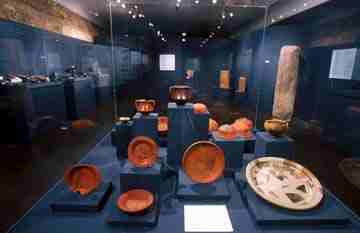Students from our school visit the Archaeological Museum in Bilbao
Today, students from our school have visited the Arkeologi Museoa, or Archaeological Museum in Bilbao, located in Calzadas de Mallona nº 2. They have had the opportunity to go round the different rooms of the museum and afterwards concentrate on the temporary exhibition, entitled “the broken plates,” dedicated to ceramics and pottery.
The guide explained in simple terms how the various ceramics on display came into being; the process from natural clay to being fired. The students have learnt the importance of ceramics, in which liquids can be boiled, which enabled man to boil and handle various types of food, which then were not poisonous at the end of this process. In the past, man used clay or mud pots for food but these could not be boiled because the mud particles would be dangerous for the human diet. Ceramic was, therefore, a revelation.
One of the most historic and importance functions of ceramics was its domestic use. The kitchen was – and still is – the place in which you find pottery the most. Man usually left traces and in the museum you can see documents that trace the use of ceramics.
The museum guide imparted a lot of information with regard to this topic. He explained, for example, that pottery needs to reach temperature of over 600 degrees Celsius to harden and since pottery came into common usage, ceramic items are usually the most frequently found objects in archaeological sites, for 2 main reasons:
- pottery was a material often used in the past to make different utensils
- objects made essentially from cooked earth aren’t as fragile as they seem. Buried objects can withstand the elements much better than other materials, such as wood, bones or metal.
These characteristics mean that pottery becomes an exceptional source of information for finding out about the lifestyle of old societies.
The students received detailed information about the processes through which clay passes until it turns into the finish product. The museum guide commented, for example, that in its natural form, clay contains other organic minerals which can harm the finished object and therefore should be removed. Occasionally, the craftsman adds non-plastic materials on purpose to achieve a paste which fits with its end purpose.
It was undoubtedly an interesting visit, in which some students asked various questions to clarify their doubts and understand our past through the –sometimes involuntary- traces that our ancestors left behind, which nowadays form an essential source of information for all of us.



 English
English Español
Español Deutsch
Deutsch Français
Français Italiano
Italiano Ру́сский
Ру́сский 

